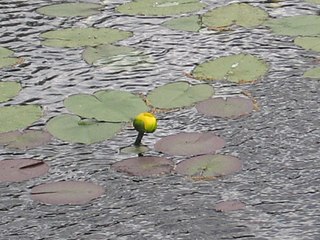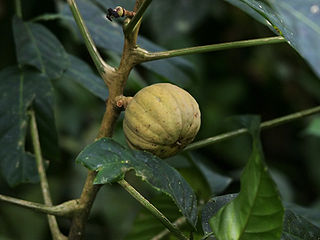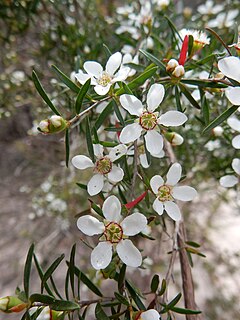
Hevea brasiliensis, the Pará rubber tree, sharinga tree, seringueira, or, most commonly, the rubber tree or rubber plant, is a flowering plant belonging to the spurge family Euphorbiaceae. It is the most economically important member of the genus Hevea because the milky latex extracted from the tree is the primary source of natural rubber.

Hevea is a genus of flowering plants in the spurge family, Euphorbiaceae, with about ten members. It is also one of many names used commercially for the wood of the most economically important rubber tree, H. brasiliensis. The genus is native to tropical South America but is widely cultivated in other tropical countries and naturalized in several of them. It was first described in 1775.

Ficus elastica, the rubber fig, rubber bush, rubber tree, rubber plant, or Indian rubber bush, Indian rubber tree, is a species of plant in the fig genus, native to eastern parts of South Asia and southeast Asia. It has become naturalized in Sri Lanka, the West Indies, and the US State of Florida.

Nuphar is a genus of aquatic plants in the family Nymphaeaceae, with a temperate to subarctic Northern Hemisphere distribution. Common names include water-lily, pond-lily, alligator-bonnet or bonnet lily, and spatterdock.

Hura crepitans, the sandbox tree, also known as possumwood and jabillo, is an evergreen tree of the spurge family (Euphorbiaceae), native to tropical regions of North and South America including the Amazon rainforest. It is also present in parts of Tanzania, where it is considered an invasive species. It can be recognized by its smooth brown bark covered in many dark, pointed spines which have led to its being nicknamed monkey no-climb.
Plant reproduction is the production of new offspring in plants, which can be accomplished by sexual or asexual reproduction. Sexual reproduction produces offspring by the fusion of gametes, resulting in offspring genetically different from the parent or parents. Asexual reproduction produces new individuals without the fusion of gametes, genetically identical to the parent plants and each other, except when mutations occur.
This page provides a glossary of plant morphology. Botanists and other biologists who study plant morphology use a number of different terms to classify and identify plant organs and parts that can be observed using no more than a handheld magnifying lens. This page provides help in understanding the numerous other pages describing plants by their various taxa. The accompanying page—Plant morphology—provides an overview of the science of the external form of plants. There is also an alphabetical list: Glossary of botanical terms. In contrast, this page deals with botanical terms in a systematic manner, with some illustrations, and organized by plant anatomy and function in plant physiology.

Bursera microphylla, known by the common name elephant tree in English or 'torote' in Spanish, is a tree in genus Bursera. It grows into a distinctive sculptural form, with a thickened, water-storing or caudiciform trunk. It is found in the southwestern United States and northwestern Mexico.

Gmelina leichhardtii, the white beech, is a tree of eastern Australia. Scattered individuals or small groups of trees naturally occur from the Illawarra district of New South Wales to near Proserpine in tropical Queensland. The white beech or grey teak is a fast-growing tree, growing on volcanic and alluvial soils in areas of moderate to high rainfall. It also grows on poorer sedimentary soils in fire free areas. White beech may occasionally be seen in Australian rainforests, though their status is considered "uncommon". Unlike the Australian red cedar, the white beech has not recovered particularly well after logging in the 19th and 20th centuries.

Kiggelaria africana is a large, robust, low-branching African tree, and is currently the only accepted species in the genus Kiggelaria.
Hevea nitida is a species of rubber tree in the genus Hevea, belonging to the family Euphorbiaceae. It is a medium-sized evergreen tree up to 27 m (90 ft) tall. It is native to the rainforests of northern Brazil and Colombia.
Hevea guianensis is a species of rubber tree in the genus Hevea, belonging to the family Euphorbiaceae. It is native to the rainforests of Ecuador, Venezuela, the Guyanas, Brazil, Colombia and Peru. It generally grows on well-drained soils or on those that are only lightly inundated, on river banks, in gallery forests, savannah forests and wooded slopes.
Hevea rigidifolia is a species of rubber tree in the genus Hevea, belonging to the family Euphorbiaceae. It is native to the rainforests of northern Brazil and Colombia, where it is endemic to localities near the upper Rio Negro, a north bank tributary of the Amazon River, and its tributary, the Vaupés River.
Hevea spruceana is a species of rubber tree in the genus Hevea, belonging to the family Euphorbiaceae. It is native to the rainforests of northern Brazil and Guyana. It is named in honour of the English botanist Richard Spruce who spent the years 1849 to 1864 exploring the Amazon basin and sending botanical specimens back to Europe.
Hevea benthamiana is a species of rubber tree in the genus Hevea, belonging to the family Euphorbiaceae. A medium-sized deciduous tree growing to a height of about 27 m (90 ft), it is native to the rainforests of northern Brazil, Colombia and Venezuela.
Hevea camargoana is a species of flowering plant in the genus Hevea, the rubber trees, belonging to the family Euphorbiaceae. It is native to the island of Marajó in the Amazon delta in northeastern Brazil where it was discovered in 1975. It is a small tree and Its typical habitat is dry savannah and woodland bordering seasonally inundated swamps.

Brachystegia laurentii, a plant in the family Fabaceae, is a species of large tree found in western Cameroon, Gabon, Equatorial Guinea, the Democratic Republic of the Congo and the Republic of the Congo. It has a dense, umbrella-shaped crown. The wood is known as bomanga and has many uses in building and construction.

Leptospermum deanei, commonly known as Deane's tea-tree, is a species of rare, slender shrub that is endemic to the northern suburbs of Sydney. It has bark peeling in long strips from the older stems, hairy young stems, narrow elliptical to lance-shaped leaves, white flowers arranged singly on short side shoots and mostly glabrous fruit.

Leptospermum emarginatum, commonly known as the twin-flower tea-tree or twin flower teatree, is a species of shrub that is endemic to south-eastern Australia. It has rough bark on the older stems, lance-shaped leaves with the narrower end towards the base and a small notch at the tip, white flowers in groups of up to five and hemispherical fruit that falls off when mature.
Salix dissa is a low shrub from the genus willow (Salix) with usually 1 to 3 centimeters long leaf blades. The natural range of the species is in China.









